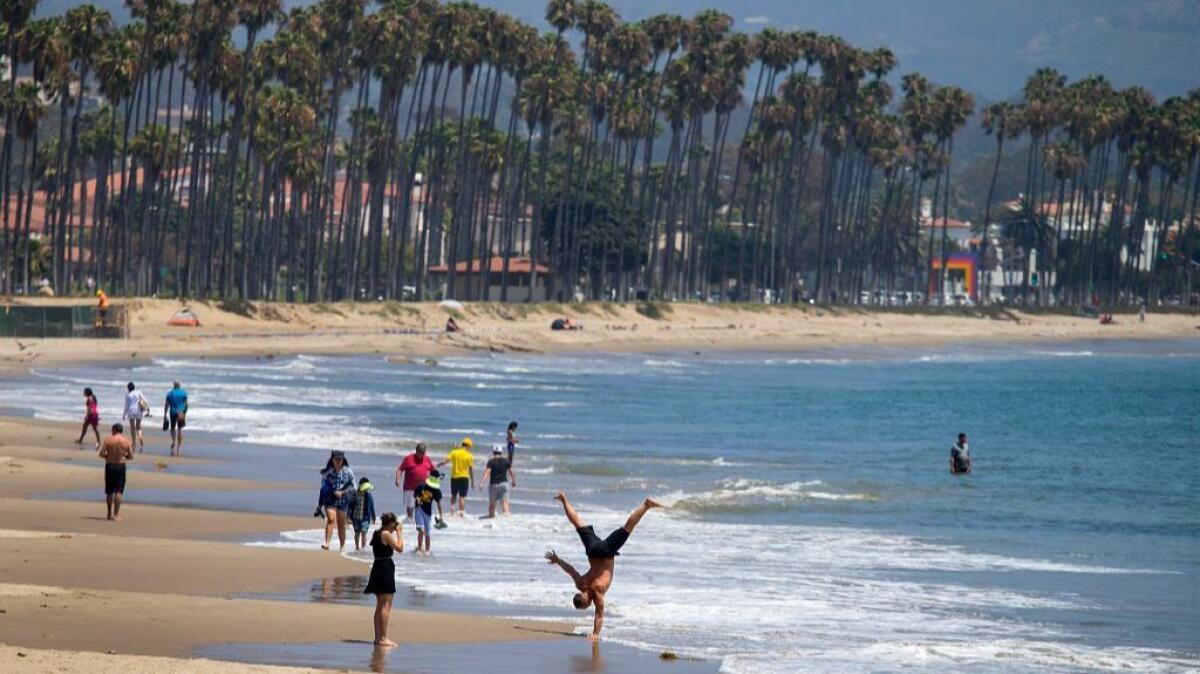Santa Barbarans are angered by Trump’s order that could lead to new offshore drilling

- Share via
Santa Barbara — From a cafe table on a pier overlooking sea lions and passing sailing vessels with bright pennants flapping in the breeze, Pedro Nava recalled that the battle lines were drawn to prevent offshore drilling in Santa Barbara when a marine sanctuary was established here in 1954.
At issue was the spread of oil derricks on the hills and streets of the nearby coastal hamlet of Summerland, which had become so polluted that a newspaper editor at the time lamented that “the whole face of the townsite is aslime with oil leakages.”
Nava, 69, a local resident and former California assemblyman, said the sanctuary initiated by then Mayor John Rickard “was the start of a new era: our economic future would be based on the scenic beauty of our coastline and tourism.”
Now, from one end of this 5-mile-long city with a population of about 91,000 people to the other, community leaders, business owners and environmentalists are reacting with anxiety and anger to the executive order President Trump signed on Friday to consider new offshore drilling in federal waters here and around the country.
There were few complaints on Saturday among the thousands of visitors, many of them clutching shopping bags, who strolled along the pier and explored downtown streets lined with boutiques, restaurants and watering holes with red-tiled roofs reflecting the city’s Spanish colonial heritage.
But behind the scenes of the city 90 miles up the coast from Los Angeles, things were anything but placid.
Victoria Fauerbach, 18, a docent at the Santa Barbara Museum of Natural History Marine Center on Stearns Wharf near downtown, was preparing to teach visiting students about the life cycle of sharks when she first heard the distressing news.
“My first thought was, ‘Do they really want to do this to our environment?’“ she recalled. “How long before we get an oil spill?”
A mile away, at the Shoreline Cafe, an eatery with beachfront dining tables set up on the strand, manager Ulises Morales shared similar concerns as he served customers enjoying Mexican dishes and sipping margaritas while pushing their toes into the sand.
Giving a sardonic smile, Morales said, “As you can see, an oil spill on the beach would not be good for us.”
Tourism and recreation are substantial drivers of California’s 19 counties adjacent to the Pacific Ocean. Together, they comprise more than 18,000 business establishments employing 368,000 persons and generating nearly $9 billion in wages, according to a 2012 study conducted by the National Oceanic and Atmospheric Administration.
Unlike many coastal destinations, however, the Santa Barbara region includes one of the largest natural oil and gas seeps in the world. Native Americans used globs of asphalt that accumulated naturally above ground to seal and waterproof the wooden planks of their boats.
A recent history of bipartisan opposition to oil drilling has been fueled with viscerally terrifying images captured live on TV of waves lubricated with oil, oil-drenched birds and frantic cleanup crews after a drill boring in federal waters in 1969 punctured a high-pressure pocket of petroleum.
An estimated 80,000 to 100,000 barrels of crude spewed uncontrolled from the breach into the blue Pacific, much of it congealing into a foot-thick mat that resembled chocolate mousse. Part of the oil was pushed southwest by winds to San Miguel Island, and the rest was carried by currents toward Santa Barbara.
The event galvanized public awareness of the environment and support for tighter regulatory control of the oil industry. In the 1980s and ‘90s, it played a role in defeating efforts by the Reagan administration and later by the first Bush administration to sink more oil wells along stretches of the California coastline, including Monterey Bay.
Former Democratic U.S. Rep. Mel Levine recalled that “the blowout that occurred in 1969 helped us make the case that whatever benefits would come to the oil industry from more offshore drilling were outweighed by potential environmental and economic costs.”
Nava said the big question in Santa Barbara now is this: “Given that the Trump’s executive order will lead him straight into federal court, what’s he trying to achieve?”
Admiring the vista of crashing waves, surfers and boats dipping and tugging at their moorings against a backdrop of the steep Santa Ynez Mountains, he added, “I really don’t get it.
“Which ones of his constituents wants to spend $300 a night at one of our motels to see dead whales and oil spills?”
More to Read
Sign up for Essential California
The most important California stories and recommendations in your inbox every morning.
You may occasionally receive promotional content from the Los Angeles Times.














